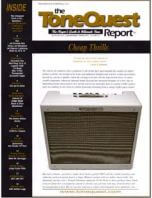
No one has ever succeeded in deciphering the infinite variations manifested by the human mind — how we inhabit the same world, yet perceive and react to every moment in our lives in such profoundly different ways. Society, education and culture provide filters intended to shape how we view the world, but each human being remains different and unique for reasons that remain a mystery. And so it goes with music and musicians…. Why do some players find their voice in a Stratocaster, while others can’t imagine playing anything but a big-ass hollow body? This is “me,” and that isn’t, but for someone else it is. Most of us hear target sounds in our head that drives our selection of instruments and gear — a sound that may change with each song, while a weekend blues player might simply wish to refine a single, signature tone in the style of Jimmie Vaughan or Albert or B.B. King. The point is, we often know where we want to go, but the shortest path to our destination isn’t always so clear. To make things more interesting, some players just want to be dropped off at the right address in the Quest for Tone, preferring to find something that works with no tweaks or modifications as quickly as possible, while others view the Quest as a journey with no defined beginning or end. To them, anything is possible until proven otherwise, they enjoy exploring new sounds, and their “failures” are often as illuminating as their successes.
We learned this lesson once again with an amp that we had initially written off, only to discover four years later that it could become one of the most extraordinary guitar amplifiers we have ever owned or reviewed. What changed? Well, with the lucid, unerring clarity of hindsight, we had to dream it first, thinking of terms of possibilities — what could be, rather than focusing solely on what was missing….
Fender ’57 Twin
The 25 watt Twin originally debuted in 1952 as the first amp with separate bass and treble controls. By 1955, the model 5E8 Twin had been upgraded to 50 watts, featuring two 5U4G rectifiers — another Fender first in guitar amplification — dual 6L6s, bass, treble and Fender’s presence control, a new fixed bias power transformer, choke, and extra gain stage and second negative feed-back loop, and the new “narrow panel” cabinet with speakers mounted in each corner. In the next circuit revision (1956–57 model 5E8A), a ground switch was added and the treble tone circuit was removed from the negative feedback loop. Leo Fender couldn’t play a lick on the guitar, but he obviously never stopped thinking about how to improve the sound and performance of his amplifiers, as evidenced by the nearly constant revisions and refinements of Fender circuits. The mighty “high power” 80 watt Twin model 5F8 appeared in1958 with four 5881s, a short-lived 83 mercury vapor rectifier that would be replaced by a single GZ34 rectifier (model 5F8-A), and a new “Middle” control added to the normal bright volume, bass, treble and presence controls. For many collectors and players who can afford them, the high powered Twin ranks with the 5F6-A Bass man as the most toneful, desirable, rare and costly Fender amps ever built.